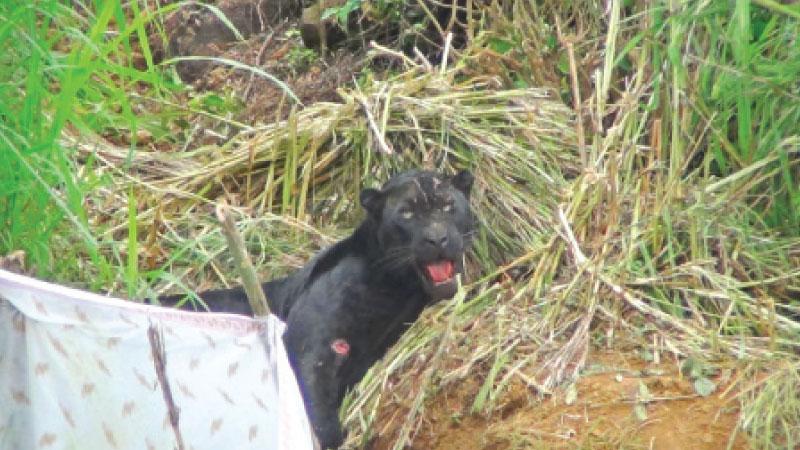
In the first week of this month, a rare black leopard endemic to Sri Lanka died succumbing to injuries suffered in a snare while receiving treatment at the Udawalawa Elephant Transit Home.
Wildlife officials found the leopard trapped in a snare but alive in the Nallathanni highlands. Director of Environmental Conservation, Sajeewa Chamikara, said that getting caught in a snare and suffering both external and internal injuries leaves only 30 per cent room for recovery in most cases. “After tranquilising, the leopard loses appetite and refuses to eat, then there is also a huge possibility of having its kidneys damaged” he said.
As explained by Sajeewa Chamikara, the black leopard falls under the species Panthera pardus kotiya and is also known as the Sri Lankan leopard. It is endemic to Sri Lanka. “This black leopard has black spots on a comparably grey skin, so it’s identified as a ‘melanistic variant’ of the Sri Lankan leopard and is not another species”.
Habitat
This rare black leopard is recorded within the Sinharaja and Sri Pada biodiversity hotspots and that is also only with a couple of sightings. “The total leopard count in Sri Lanka is between 700 – 1000 and from that there is only three or four per cent of black leopards.
These genes are getting extinct from the world” said Sajeewa. Also, no official count of black leopards has been done in Sri Lanka so far.
“This creature usually turns up in the night so that it’s unlikely to get spotted and he comes out only to find prey”. Sajeewa also added that their habitats are highly impacted and endangered and emphasised the fact that the forest reserves are a requisite for the survival of these animals .
Snare traps
Leopards have been caught in wire snares throughout the past ten years and 90 per cent of them have died in spite of the hard work of the Department of Wildlife Conservation. In many of the provinces in Sri Lanka, people who live in estates use snares mostly during dry weather for poaching. By and large, they trap animals to prevent their livelihoods from getting devastated and on the other hand, they also use snares to catch wild boar, especially, at a time like this when they lack money for food.
The most compelling fact here is that even though a leopard has been trapped by a snare, on the whole, these snares are not laid targeting leopards.
There are wildlife zones, wildlife sanctuaries and forests in Sri Lanka which are closely affiliated with the tourism industry. In fact, the wildlife strengthens the country’s economy if it is well protected. Therefore, if we can invest some percentage of the income the wildlife earns for their own betterment, Sri Lanka would have both the beauty and the blessing of the variety of its wildlife in the future as well. According to Environmentalist, Nayanaka Ranwella, focusing attention on establishing veterinary centres in wildlife zones identified as habitats of leopards would do a lot in making the circumstances better since centres such as the Udawalawa Elephant Transit Home are way too far.
“The leopard is a highly protected species according to section 30 of the Flora and Fauna Protection Ordinance.
Therefore, laying snares and other traps to kill a protected species in a protected area is illegal. Yet, these laws don’t function properly,” said Sajeewa Chamikara.
Commenting on the existing law, Nayanaka Ranwella said that the Department of Wildlife Conservation has not streamlined the law pertaining to snare traps and that they have neglected the whole mechanism not only in this particular instance, but also in regulating similar incidents.
Remonstrance
Speaking to the Sunday Observer, Ecologist, Co-founder and Managing Trustee of the Wilderness and the Wildlife Conservation Trust (WWCT) Anjali Watson, said that unfortunately the law is not very clear in this regard and that everyone has a role including the estate people and management to play in restraining the incidental snaring of leopards.
There were several complaints against the Department of Wildlife Conservation, that the wildlife officials took very long to reach the animal after being informed. Speaking on the dissension which arose with their efforts in treating the leopard, Director General, DWC, Chandana Sooriyabandara, said, “Our officials from both Randenigala and Udawalawa had reached the place as soon as they received the message. But it took a certain amount of time depending on the distance and in addition, the officials from the Nallathanniya centre had also reached there immediately.”
He added that the Wildlife officials go through much when handling an animal in such instances and also that they risk their lives in the process.
According to Sooriyabandara, the most efficient way in dealing with similar circumstances in the future would be in minimising the time and distance invested in treating a trapped animal.
Steps to be followed
According to former Director General of the Department of Wildlife Conservation, Sumith Pilapitiya, the law related to snares and traps has to be strengthened and the people, especially in the tea estates, should be well – informed about the law and the punishments if anything illegal takes place. In addition, Sajeewa Chamikara said that appointing authorities who can take charge of providing equipment and necessary information regarding the law should be prioritised.
He also stressed the importance of banning deforesting LRC lands for tea estates which makes these animals lose their territory and natural habitat.
Additionally, more suggestions have been made such as, setting up a wildlife intelligence unit to find who sets up snares and taking legal measures against the culprits and essentially, making the future generation aware of the value of wildlife for the country as a whole.
